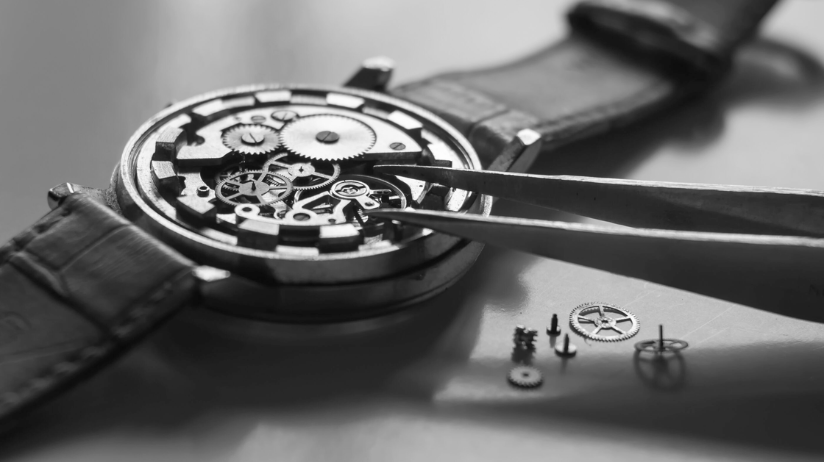Why Do Watches Lose or Gain Time and How to Fix It
By Admin
Published on 2025-11-03 16:33:00

This blog reveals the science behind why watches go fast or slow, including how movement type, battery life, and even storage position affect timekeeping.
When your watch doesn’t tell the time as precisely as it should, it can feel frustrating. But before you assume it’s broken, know this, small variations are normal and can happen to any watch. Whether you’re wearing a classic mechanical timepiece, a modern quartz model, or even a hybrid design, each works differently and can be affected by a variety of factors. The good news is that most issues affecting watch time accuracy are understood and often fixable.
This guide explains why watches gain or lose seconds, the science behind different movements, and what you can do at home before considering professional watch repair.
The Science of Timekeeping
At its core, a watch is a device that counts consistent beats of time. How those beats are measured depends on the type of movement inside.
Mechanical watches rely on a balance wheel and hairspring oscillating back and forth. Think of it as a pendulum in miniature. The regularity of this motion determines the seconds, minutes, and hours.
Quartz watches use a battery to send electricity through a quartz crystal. The crystal vibrates at 32,768 times per second, an incredibly stable rhythm that makes quartz models highly accurate.
Hybrid or smartwatches combine digital circuits with either quartz or mechanical components, sometimes powered by solar energy. These often sync with digital systems, but they are not immune to accuracy issues either.
Understanding these foundations makes it easier to spot what’s causing your watch to drift from precise timekeeping.
Why Mechanical Watches Lose or Gain Time
If you wear a mechanical watch, including an automatic watch, it’s normal to notice small deviations. Here’s why:
- Magnetism: Everyday objects like laptops, phones, or magnetic clasps can magnetize the hairspring, causing the balance wheel to move unevenly. This can make your mechanical watch time accuracy drift by several seconds or more per day.
- Lubrication: Inside every mechanical movement are gears and pivots that rely on fine oils. Over time, these oils dry up, causing friction that slows or speeds up the mechanism.
- Shocks and bumps: Mechanical watches are delicate. Dropping or knocking them against hard surfaces can disturb their movement and throw off accuracy.
- Temperature changes: Sudden shifts from hot to cold can cause the tiny parts of the movement to expand or contract, leading to small but noticeable time variations.
On average, even the best mechanical watches can gain or lose anywhere from 5 to 20 seconds per day. Luxury chronometers often do better, but they still require care to maintain consistency.
Why Quartz Watches Drift
Quartz models are known for precision, but they aren’t perfect either. If you’ve noticed your quartz watch time accuracy changing, these are the likely reasons:
- Battery drain: As a watch battery weakens, the voltage drops, and the quartz oscillator becomes less reliable. This can cause seconds to be skipped or delayed.
- Circuit issues: Moisture or dust that enters the case can interfere with the electronics, leading to irregular performance.
- Temperature sensitivity: Although quartz is highly stable, extreme cold or heat can slightly alter the frequency of vibration, causing deviations of a few seconds per month.
Most quartz watches lose or gain only about 15 seconds in an entire month, which is why they’re often preferred for everyday wear. Still, replacing the battery regularly and keeping the watch clean is essential.
Accuracy in Hybrid and Solar Watches
Smartwatches, solar-powered models, and hybrids sit in between traditional quartz and mechanical pieces. While they often boast incredible accuracy by syncing with atomic clocks or GPS systems, they still face issues.
- Solar watches may show irregularities if the rechargeable cell is running low.
- Digital watch time accuracy depends on the stability of internal circuits, which can drift if the watch overheats or the software glitches.
- Smart hybrids that combine analog displays with digital modules may lose precision if sensors or syncing functions fail.
These watches are often marketed as maintenance-free, but keeping them fully charged and updated is key to long-term precision.
Quick Fixes You Can Try at Home
If your watch is running too fast or too slow, you don’t always need professional help right away. Some issues can be corrected with simple steps.
- For mechanical watches: Use a demagnetizer if you suspect magnetic exposure. These small devices are inexpensive and can restore balance wheel function. Regular winding also ensures even tension in the mainspring.
- For quartz watches: Replace the battery if it’s been more than two years. Always use quality batteries to avoid leakage.
- For hybrid or digital models: Reset the watch using the manufacturer’s recommended method. A hard reset often clears minor software or sensor errors.
Trying these at-home solutions can solve many common problems and restore better watch time accuracy without a service appointment.
When to Seek Professional Watch Repair
Some issues require expert care, especially for high-end watches. Here are signs that it’s time to book a service:
- Your automatic or mechanical watch is losing more than 30 seconds daily, even after winding.
- The second hand on a quartz watch jumps erratically or stalls.
- A digital display flickers, resets randomly, or stops despite a fresh battery.
- Water or condensation appears under the glass.
Professional servicing includes cleaning, re-lubricating, and calibrating the movement. Skilled technicians can also regulate mechanical watches to restore them to factory accuracy standards.
Preventing Future Accuracy Problems
Keeping your watch precise is easier when you build a few good habits into your routine.
- Store your watch away from magnets, electronics, and direct sunlight.
- For mechanical watches, wind them regularly and avoid letting them sit unused for months.
- Replace quartz batteries before they die completely to prevent acid leaks.
- Keep your watch clean, wiping away sweat or dust after wear.
- Service mechanical models every three to five years, depending on the manufacturer’s guidelines.
With the right care, you can enjoy stable performance and reliable timekeeping from any type of watch.
Every watch, whether mechanical, quartz, or hybrid, will eventually lose or gain time. It doesn’t mean the watch is faulty, it simply means the movement is responding to its environment, wear, and age. By understanding what affects watch time accuracy, you can take the right steps to protect your timepiece and keep it running smoothly. From simple at-home fixes like battery changes and demagnetizing, to knowing when it’s time for professional watch repair, the key is regular care.
If you found this guide helpful, follow VibenVenture for more insights, tips, and practical guides on watches and timekeeping.
You dress for comfort, or confidence, or maybe chaos. But your clothes are already telling your story before you even say a word.
Before a word leaves your mouth, your outfit has already spoken. That oversized sweater you keep reaching for? It might be whispering comfort. That tailored blazer you break out on big days? It’s announcing confidence, capability, and control. Our outfit choices often say what we haven’t found the words for yet. It’s the emotional truths and triggers behind clothing that turn a closet into something more than storage, it's a gallery of your inner world.
Style doesn't just consist of trends alone. It’s an constantly changing language we speak to the world around us. And often, without knowing it, we’re broadcasting our moods, boundaries, histories, and even our aspirations. The way we dress is an invitation to connect or a subtle signal to keep a respectful distance.
If you look closely, you’ll notice patterns in your clothing habits. There are days when you throw on something bold to feel seen. There are also days when you fold into your softest hoodie because you need to feel safe. The connection between clothes and emotions is incredibly real. And the more tuned in you are, the more you can learn about yourself without saying a word.
Emotional Dressing Is Real
Let’s drop the idea that getting dressed is just a routine task. Because the truth is, emotional dressing happens daily. That rush of calm when you put on your go-to jeans? That little lift you feel when your favorite clothes still fit after a rough week? And no it’s not just the texture or the fabric, but actually you feel seen and oddly soothed.
Science has actually backed this up. Studies show that clothing colors and emotions are deeply intertwined. People often gravitate toward darker tones like navy, charcoal, or deep green when feeling low, and opt for bright shades like red or yellow during periods of energy and confidence. Color has a way of expressing what we’re not ready to verbalize, making it a powerful tool in our emotional toolkit.
And then there's the act of getting dressed itself. On days when the world feels heavy, pulling yourself together with intention, even if it’s just a soft tee and your best-fitting trousers can feel like reclaiming a bit of control. Our outfit choices may be rooted in aesthetic, but they often reveal much more about our internal weather.
Your "Go-To" Outfit Isn’t Random
Everyone has one. The outfit that feels like a reset button. Maybe it’s a flowy dress that catches the light just right, or maybe it’s a black-on-black combo that makes you feel quietly powerful. But here’s the thing: that favorite outfit didn’t earn its place by accident. It did so because it offers emotional safety. Maybe it reminds you of a time you felt admired. Maybe it simply doesn’t ask too much of you.
These are the garments that act like emotional armor. They allow you to move through your day without questioning if you look okay. They offer familiarity in moments of instability. And the emotional connection we form with them goes far beyond style. They’re rooted in memory, identity, and yes, even vulnerability.
Fashion has its moods, but your emotional clothing truths run deeper. Sometimes, the simplest top carries the heaviest meaning. And that’s what makes your wardrobe personal consist of emotional alignment not just trends.
When Style and Personality Finally Sync
Ever met someone whose outfit just makes sense with who they are? Their clothing seems to mirror their presence. Nothing feels forced, nothing screams for attention and yet, you notice them. That’s style meeting personality at a soul level.
When your style choices stop trying to impress and start reflecting your essence, everything clicks. The textures, the silhouettes, even the little rips or rolled-up sleeves, they all feel intentional.
There’s also freedom in not needing to explain your fashion anymore. The moment you start dressing for yourself, your style becomes easier to trust. You stop second-guessing outfit choices. You stop shopping for approval. Instead, you start owning your narrative without needing to speak a word. That’s what your clothes say about you when they’re finally aligned with who you are.
Rebuilding a Wardrobe That Feels Like You
If you’ve ever looked into a closet full of clothes and thought, "I have nothing to wear," it’s rarely about quantity. More often, it’s about disconnection. Those pieces might fit your body, but not your current self. And that's your signal: it’s time to rebuild.
But rebuilding doesn’t mean starting over. It means listening in. What colors have been resonating with you lately? What shapes make you feel most at home in your skin? These are the subtle emotional clues that guide wardrobe changes that actually stick.
Start by identifying the pieces you keep reaching for. What do they have in common? Is it comfort? Is it confidence? Let those favorite clothes guide the blueprint for what comes next. This kind of intentional shopping leads to a closet filled with things that speak to your now, not your past or your Pinterest board.
Letting go of clothes that feel performative is one of the most freeing things you can do. Maybe they were trendy, maybe they got you compliments, but if they never felt like you, they were just costumes. Dressing with authenticity means choosing what mirrors your insides, even when it doesn’t match the outside noise.
The goal isn’t to follow style rules but to follow emotional alignment. The connection between clothes and emotions becomes clearer when your closet feels more like a reflection than a projection. And when that happens, dressing becomes less about decision fatigue and more about emotional fluency.
Fashion isn’t shallow. It’s layered with meaning. Every outfit tells a story, every clothing choice carries weight. From emotional triggers to quiet truths, our clothes often speak louder than we do. When you tune in to what your favorite clothes are saying, you’re not just decoding a wardrobe, you’re learning to hear yourself more clearly. So next time you reach for that hoodie or blazer or flowy skirt, pause. Ask yourself what story it’s telling today. Because chances are, it’s already speaking volumes.
For more on clothing and fashion, follow VibenVenture.




